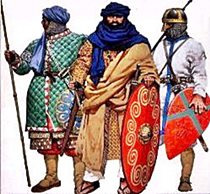
Battle of Mount Aurasium(Zerbule) |
year: 540 |
| Victory of the Imperial army against Moorish tribes | ★ ★ ★ ★ ★ |
|
enemy: Berbers
|
location: In the Aures mountains south of the Roman city Thamugad in NE Algeria
|
accuracy:
●●●●●
|
|
battle type: Mountain Battle |
war: Berber Tribes Rebellions |
modern country:
Algeria |
| ▼ The Byzantines(emperor: Justinian I) | ▼ The Enemies | |
| Commander: | Solomon | Iavdas |
| Forces: | ||
| Losses: |
| Background story: |
| After the end of the rebellion of the Carthage army (536-537), the governor of North Africa Germanus was called back to Constantinople in 539 and the eunuch Solomon replaced him combining in his person the posts of magister militum and praetorian prefect (in the meantime, he had also been raised to the rank of patricius and named an honorary consul). In 540, Solomon led his army to the south against the Moors of Mount Aurasium (i.e. Aurès Mountains, an eastern prolongation of the Atlas Mountain in NE Algeria). |
The Battle: |
 Berber warriors Solomon and his troops plundered the fertile plains around Thamugad, gathering the rich harvest for themselves, before moving onto Zerboule. Once there, they found Iavdas gone, having fled to the remote fortress of Toumar. The Byzantines moved up to besiege Toumar, but the siege proved problematic because of the barren terrain, and in particular the lack of water. While Solomon was considering how best to attack the inaccessible fortress, a minor skirmish between the two forces gradually escalated into a full-scale and confused battle, as more and more soldiers from both sides joined in. The Byzantines emerged victorious, while the Moors fled from the field. Shortly after, the Byzantines also captured the fort at the so-called “Rock of Geminianus”, where Iavdas had sent his wives and treasure. This victory left Solomon in control of Aurasium, where he built a number of fortresses. With Aurasium secured, effective Byzantine control was established in the provinces of Numidia and Mauretania Sitifensis. |
Aftermath: |
| Aided by the captured treasure of Iavdas, Solomon extended his fortification program in these two provinces: some two-dozen inscriptions testifying to his building activity survive from the area. |
|
|
